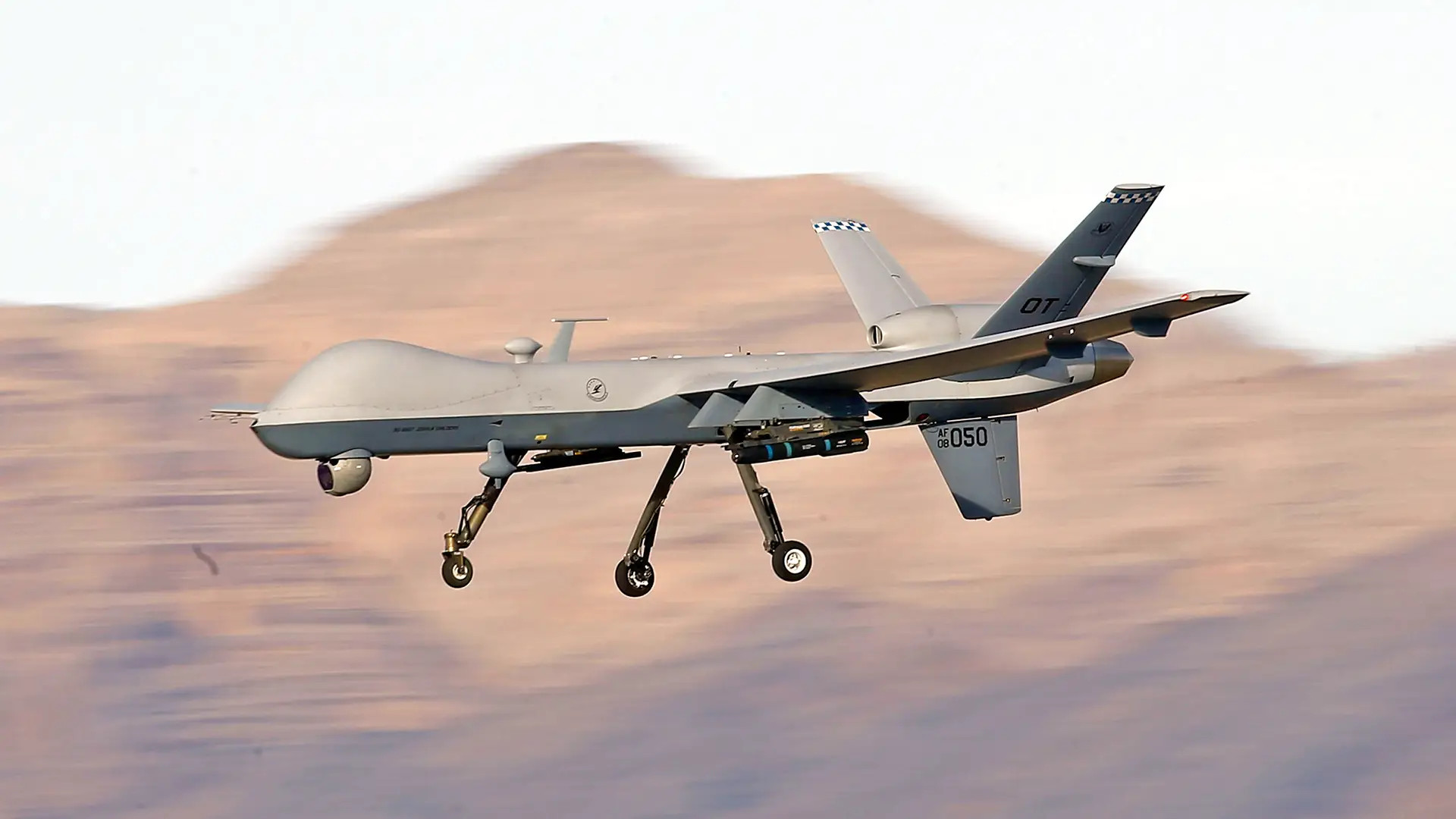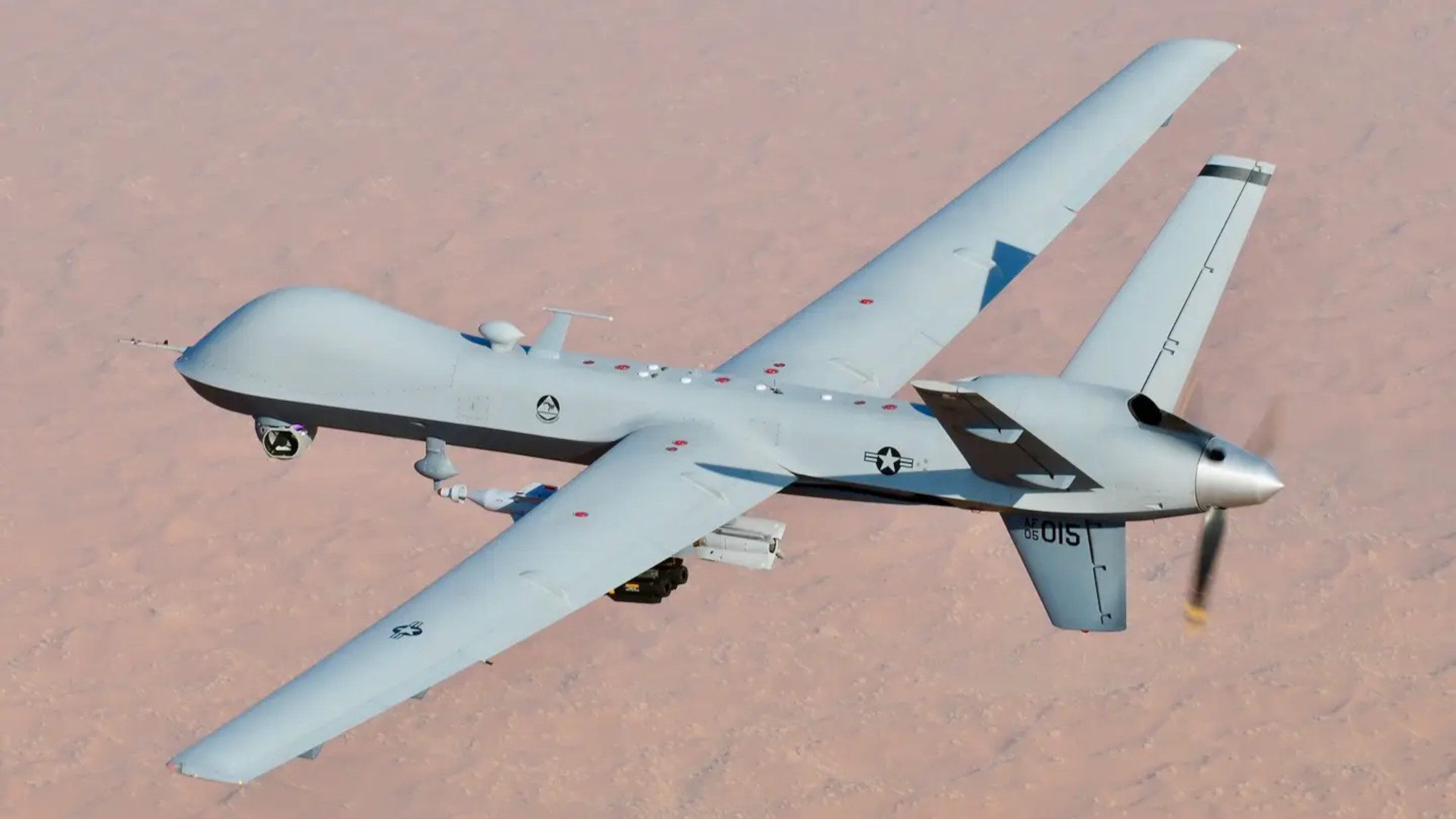Iranian-backed Houthi militants in Yemen reportedly shot down a U.S. MQ-9 Reaper drone off the country’s coast earlier today. The incident comes as the Houthis have been firing cruise and ballistic missiles and launching drones at targets in Israel in response to that country’s ongoing operations in the Gaza Strip.
The AP was among the first to report that the U.S. military is still assessing the particulars of today’s incident.
“We can confirm that a U.S. military MQ-9 remotely-piloted aircraft was shot down while in international airspace over international waters off the coast of Yemen,” a senior U.S. defense official said according to Fox News‘ Jennifer Griffin. “U.S. Central Command officials are assessing the incident.”
The War Zone has reached out to U.S. Central Command (CENTCOM), the Office of the Secretary of Defense, and the White House’s National Security Council (NSC) for more information.

“Our air defenses were able to shoot down an American MQ9 aircraft while it was carrying out hostile, monitoring and spying activities in the airspace of Yemeni territorial waters,” a statement from the Houthi’s self-styled Yemeni Armed Forces claimed. The group also asserted, without providing any evidence, that the drone was operating at the time “within the framework of American military support for” Israel.
“The Yemeni Armed Forces affirm their legitimate right to defend the country and confront all hostile threats,” the statement, relayed on X (formerly Twitter), added. “Hostile movements will not deter the Yemeni armed forces from continuing to carry out military operations against the Israeli entity in support of the oppression of the Palestinian people.”
The Iranian-backed group subsequently released a video it claims shows the shootdown, but the footage cannot be readily verified.
Additional images had been circulating online in relation to today’s incident, but actually show previous shootdowns of Saudi Arabian drones.
If the shootdown did occur, it remains unknown who the MQ-9 belonged to specifically or what it was doing at the time.
There has been a significant amount of U.S. military activity in and over the Red Sea recently. Just in terms of naval vessels, a U.S. Navy carrier strike group and an expeditionary strike group, the latter of which is full of amphibious ships loaded with Marines (including their aircraft), along with their escorts, are now in the area. USS Florida, one of the Navy’s four highly capable Ohio class guide missile submarines, is also moving through that body of water.
U.S. Air Force combat jets and bombers, among other aircraft, have been flying above, too.
So, there is certainly the possibility that MQ-9s, including ones operated by the U.S. Marine Corps, as well as the U.S. Air Force, could be helping provide overwatch in support of these movements or otherwise gathering intelligence, especially around the Bab Al Mandeb Strait that links the Red Sea to the Gulf of Aden. This is a highly strategic, but also potentially dangerous choke point with Yemen on one side.
The Houthis have anti-ship cruise missiles, explosive-laden kamikaze drone boats, and naval mines that could all put U.S. naval vessels at risk. They also have an array of surface-to-air weapons. This includes purpose-built and improvised surface-to-air missile systems and other novel capabilities. The improvised air defense systems combine repurposed heat-seeking air-to-air missiles with a targeting system that involves forward-looking infrared (FLIR) sensor turrets scrounged from other sources. The Houthis now routinely release infrared footage of claimed shootdowns, just like they did today.
Much of the more advanced elements of the group’s overall arsenal, which it routinely puts to use, are at least based on Iranian designs if not directly supplied by Iran’s regime.
These recent U.S. movements in the region are all part of broader U.S. efforts to bolster its posture in the Middle East in response to the ongoing Israel-Gaza conflict, and to deter Iran and its other proxies from getting more involved. The deployments so far have included a bevy of naval assets, including the ones mentioned already, along with multiple squadrons of combat jets, an array of additional air and missile defenses, and more.
In addition, the U.S. Air Force has been conducting Reaper sorties over and around Yemen for years now as part of a campaign to “degrade” Al Qaeda and now ISIS-linked terrorist groups in the country. Officially, this is separate from the Saudi Arabian-led coalition supporting the internationally recognized government of Yemen against the Houthis. In the last year or so, the Saudis have shifted their focus from all-out conflict with the Houthis to more active efforts to reach a negotiated settlement to the country’s long-running civil conflict.
However, the lines between these two ostensibly separate campaigns have often been blurred and this would not be the first time the Houthis have shot down a U.S. MQ-9 flying over the country. The Houthis have also attacked U.S. naval vessels in the past.
It is also worth noting that the group has also claimed to have knocked out American Reapers in the past only for it to turn out that they were Chinese-made drones belonging to the Saudis.
The U.S. military has also acknowledged sending unarmed Reapers over Gaza, ostensibly to help Israeli forces find and rescue hostages.
Broadly speaking, there is a lower risk of escalation, and even potentially any kind of immediate retaliation, from shooting down drones given that there are no humans onboard who could be killed or injured in the process. This, in turn, lowers the risk calculus threshold when it comes to engaging uncrewed aircraft. This reality has also been evidenced by the Iranian shootdown of a U.S. Navy RQ-4N Broad Area Maritime Surveillance Demonstrator (BAMS-D) drone flying over the Gulf of Oman in 2019 and the circumstances that led to the loss of another Reaper over the Black Sea earlier this year after a Russian Su-27 Flanker fighter collided with it.

As already noted, this new incident comes amid conflict that has erupted between Israel and militant groups in the Gaza Strip, which also prompted concners about growing regional spillover as a result. The Palestinian terrorist group Hamas’ unprecedented terrorist attacks on southern Israel on October 7 precipitated the current crisis. Since then, the Houthis have publicly confirmed that they have been attempting to strike Israel using land-attack cruise and ballistic missiles, as well as drones.
The U.S. military, in turn, has shown a willingness to engage those threats directly. Over the course of nine hours on October 19, the U.S. Navy’s Arleigh Burke class destroyer USS Carney shot down four cruise missiles and 19 drones the Houthis had launched as they passed over the Red Sea.

The reported MQ-9 shootdown also comes as American forces in Iraq and Syria have been subjected to a steady stream of attacks from Iranian-support groups that have caused dozens of injuries so far. The U.S. military carried out a new retaliatory airstrike on an Iranian-linked target in Syria just today in response to these threats. This follows a pair of airstrikes on other sites in Syria last month.
What might happen now in response to the reported downing of the Reaper by the Houthis remains to be seen.
We will continue to update this story as more information becomes available.
UPDATE 8:20 PM EST:
A senior U.S. defense official has now confirmed to The War Zone and other outlets the Houthis did indeed shoot down an MQ-9 Reaper earlier today. In addition, they confirmed that the incident took place over the Red Sea, just as we surmised might be the case, and also said that the drone was over international waters at the time, counter to the claims of the Yemeni militant group.
“As you would imagine, we’re always concerned with where one of our aircraft goes down,” the senior military official said when asked about any plans to recover the drone.
Howard Altman contributed to this story.
Contact the author: joe@thedrive.com
